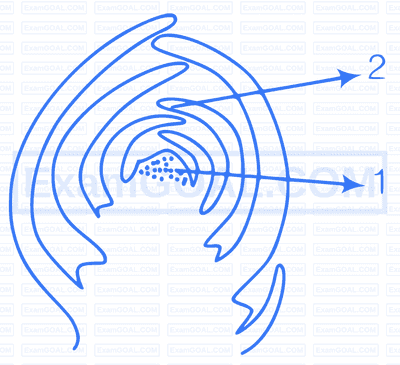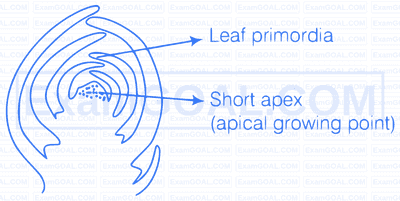The meristematic cells can be identified of the basis of the following characteristics
(i) Cell have thin cellulose wall and dense cytoplasm with large nucleus.
(ii) Plasmodesmal connections are more numerous among meristematic cells.
(iii) Cell division, i.e., mitosis and its various stages are distinctly visible.
(iv) Chromosomes of cells replicate and divide into two homologous chromatids.
All these features contribute to open ended growth where structure is never complete in meristematic regions.
Whereas, cells incapable of divinding show features such as
(i) attains particular shape, size and thickening.
(ii) Undergoes structural and physiological differentiation.
(iii) Different types of cell are formed such as epidermis, cortex, vascular tissues.
| Elasticity | Plasticity |
|---|---|
| The elasticity is stretchability of the plant cells or products, e.g., rubber/latex etc. The elastic substances can revert back to its original form in relaxed state. e.g., stretching of rubber. |
Different pathways in response to environment or phases of life to form different kinds of structure is called plasticity. The plastic substances and phenomenon of plasticity are not reversible, i.e., irreversible. e.g., difference in shapes of leaves produced in air and those produced in water in buttercup. This is also known as heterophylly. |
Label the diagram
A. This is which part of a dicotyledonous plants?
B. If we remove part 1 from the plant, what will happen?

Representation the labelling of the given diagram is as follows

A. The plant part in the given diagram is growing shoot apex.
B. Removal of shoot apex will help to overcome the apical dominance. Thus, the lateral buds grow faster, giving rise to branches and give the plant a bushy appearance.
Growth and differentiation in plant and animals can be explained as follows
| Growth in Plants | Growth in Animals |
|---|---|
| Plant growth is indeterminate, i.e., cells can divide and enlarge continuously for life time. |
Animal growth is determinate i.e., till finite period, they mature and stop growing externally. |
| Growth is open due to presence of meristematic cells which keep dividing, i.e., growing and replacing new organs. | Cell division is distributed through-out the body of organism to replace old and damaged cells, rather localised at specific regions. |
| Structure in plants at tips or meristematic zones is never complete, owing to open ended tips or apices. | After a specific time period i.e., embryonic, the growth rate is reduced in juvenile phase and ceases in maturity. |
| Plant growth is in a modular fashion, i.e., grows longitudinally, laterally and in grith. |
Sponges are exception to this. They show open growth as every cell of their body can give rise to an individual and their growth and differentiation is continuous is their life cycle.